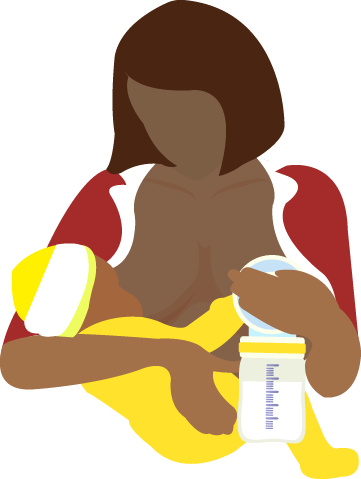You should plan to return to your pre-pregnancy weight by 6 to 12 months after delivery. Most women lose half of their baby weight by 6 weeks after childbirth (postpartum). The rest most often comes off over the next several months.
A healthy diet with daily exercise will help you shed the pounds. Breastfeeding can also help with postpartum weight loss.
Take Your Time
Your body needs time to recover from childbirth. If you lose weight too soon after childbirth, it can take longer for you to recover. Give yourself until your 6-week checkup before trying to slim down. If you are breastfeeding, wait until your baby is at least 2 months old and your milk supply has normalized before drastically cutting calories.
Aim for a weight loss of about a pound and a half a week. You can do this by eating healthy foods and adding in exercise once you are cleared by your health care provider for regular physical activity.
Women who are exclusively breastfeeding need about 500 more calories per day than they did before pregnancy. Get these calories from healthy choices such as fruits, vegetables, whole grains, and lean protein.
DO NOT drop below the minimum number of calories you need.
Breastfeeding
If you are breastfeeding, you will want to lose weight slowly. Weight loss that happens too fast can make you produce less milk. Losing about a pound and a half (670 grams) a week should not affect your milk supply or your health.
Breastfeeding makes your body burn calories which helps you lose weight. If you are patient, you may be surprised at how much weight you lose naturally while breastfeeding.
Eat to Lose Weight
These healthy eating tips will help you lose weight safely.
DO NOT skip meals. With a new baby, many new moms forget to eat. If you do not eat, you will have less energy, and it will not help you lose weight.
Eat 5 to 6 small meals a day with healthy snacks in between (rather than 3 larger meals).
Eat breakfast. Even if you do not normally eat in the mornings, get into the habit of having breakfast. It will give you energy to start your day and stop you from feeling tired later.
Slow down. When you take your time eating, you will notice that it is easier to tell that you are full. It is tempting to multitask, but if you focus on your meal you will be less likely to overeat.
When you reach for a snack try to include foods with fiber and protein to help keep you full (such as raw bell pepper or carrot with bean dip, apple slices with peanut butter, or a slice of whole-wheat toast with hard-boiled egg). Drink at least 12 cups of fluid a day.
Keep a water bottle near the spot where you usually feed the baby, that way you’ll remember to drink when they do.
Limit drinks like sodas, juices, and other fluids with added sugar and calories. They can add up and keep you from losing weight. Avoid products with artificially sweeteners.
Choose whole fruit over fruit juice. Fruit juices should be taken in moderation because they can contribute extra calories. Whole fruit gives you vitamins and nutrients and contains more fiber, which helps you feel full with fewer calories.
Choose broiled or baked rather than fried foods.
Limit sweets, sugar, saturated fat and trans fats.
Do Not Crash and Burn
DO NOT go on a crash diet (not eating enough) or a fad diet (popular diets that limit certain types of foods and nutrients). They will probably make you drop pounds at first, but those first few pounds you lose are fluid and will come back.
Other pounds you lose on a crash diet may be muscle instead of fat. You will gain back any fat you lose on a crash diet once you return to normal eating.
Be Realistic
You may not be able to return to your exact pre-pregnancy shape. For many women, pregnancy causes lasting changes in the body. You may have a softer belly, wider hips, and a larger waistline. Make your goals about your new body realistic.
Exercise
A healthy diet combined with regular exercise is the best way to shed the pounds. Exercise will help you lose fat instead of muscle.
Once you are ready to start losing weight, eat a little less and move a little more each day. It may be tempting to push yourself into a hard routine for fast weight loss. But rapid weight loss is not healthy and is hard on your body.
DO NOT overdo it. Just a quick walk around the block with your baby in the stroller is a great way to start adding exercise to your daily routine.
References
Berger AA, Peragallo-Urrutia R, Nicholson WK. Systematic review of the effect of individual and combined nutrition and exercise interventions on weight, adiposity and metabolic outcomes after delivery: evidence for developing behavioral guidelines for post-partum weight control. BMC Pregnancy and Childbirth. 2014;14:319. PMID: 25208549 www.ncbi.nlm.nih.gov/pubmed/25208549.
Isley MM, Katz VL. Postpartum care and long-term health considerations. In: Gabbe SG, Niebyl JR, Simpson JL, et al, eds. Obstetrics: Normal and Problem Pregnancies. 7th ed. Philadelphia, PA: Elsevier; 2017:chap 23.
Lawrence RA, Lawrence RM. Maternal nutrition and supplements for mother and infant. In: Lawrence RA, Lawrence RM, eds. Breastfeeding: A Guide for the Medical Profession. 8th ed. Philadelphia, PA: Elsevier; 2016:chap 9.
Newton ER. Lactation and breastfeeding. In: Gabbe SG, Niebyl JR, Simpson JL, et al, eds. Obstetrics: Normal and Problem Pregnancies. 7th ed. Philadelphia, PA: Elsevier; 2017:chap 24.
U.S. Department of Health and Human Services and U.S. Department of Agriculture. 2015 – 2020 Dietary Guidelines for Americans. 8th Edition. December 2015. health.gov/dietaryguidelines/2015/resources/2015-2020_Dietary_Guidelines.pdf. Accessed November 8, 2019.
Review Date 11/7/2019
Updated by: John D. Jacobson, MD, Professor of Obstetrics and Gynecology, Loma Linda University School of Medicine, Loma Linda Center for Fertility, Loma Linda, CA. Also reviewed by David Zieve, MD, MHA, Medical Director, Brenda Conaway, Editorial Director, and the A.D.A.M. Editorial team
Source: https://medlineplus.gov/ency/patientinstructions/000586.htm#:~:text=You%20should%20plan%20to%20return,help%20you%20shed%20the%20pounds.




